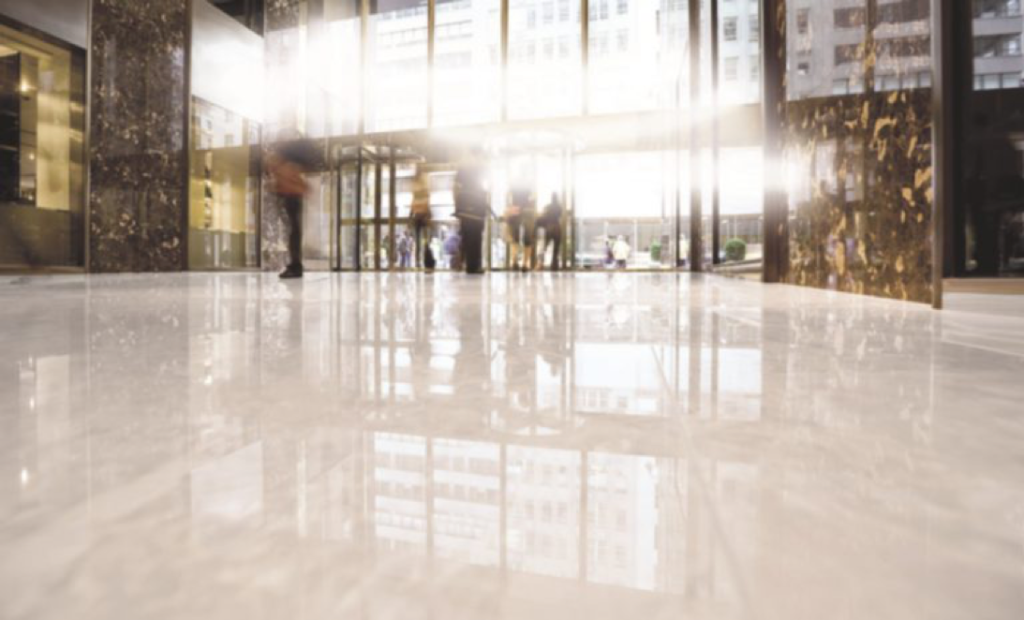Can You Clean It?
A few years back, a new bank and bank building opened in San Francisco. Because the City by the Bay is already laden with scores of banks and banking services, this new organization went out of its way to build a new facility that was architecturally interesting and impressive. And, sure enough, it was.
Articles were written about how attractive the building was, and accolades were cast upon the architect. The exceptional design fulfilled its mission. Many business owners near the bank took notice, liked the way the building looked, wanted to work with a smaller bank, and decided to move their banking needs to the new organization.
Once the building was completed, the new bank had to hire a cleaning crew to maintain the facility. This is when the new facility started showing its blemishes. It had nothing to do with the cleaning company selected; they did a fine job and at a fair price. While the building was architecturally pleasing, many of the interior touches proved very hard and complicated to clean and maintain.
Here are just two of the issues that soon came up:
The three-story building had a series of flush-mounted lights over a two-story lobby and atop a winding staircase. Extension poles for changing the lights proved useless and this building, while new at the time, used traditional floodlights that burned out frequently. The only option was to install scaffolding in the lobby, which was costly and an unexpected expense. The architect had designed the facility with décor in mind, not necessarily about how to change the light bulbs.
The building also had three conference rooms, all with kitchenettes. The counters were covered with polished, Carrara marble, personally selected by the architect to give the rooms a very high-end look. While attractive, these surfaces also became stained very easily; left burn marks if a hot item, such as a coffee pot, was placed on the marble; and because marble is porous, discoloration occurred. Ultimately, the marble had to be honed (sanded) and re-polished on a regular basis – another unexpected cost issue.

Restrooms Designed for Cleaning
Just as with this bank, building owners, architects, and designers spend months going over every detail for a new facility to satisfy the client. Significant time is devoted to decisions ranging from what light fixtures to install to what color of floor coverings to choose, and so on. However, in far too many situations, there is one aspect of building planning and construction that is often overlooked: is the building designed for cleaning?
Many facilities are simply not constructed with cleaning in mind, and we find this most frequently in restrooms. Typical examples include: soap dispensers that drip on walls, floors, or countertops, usually marring the surface; paper dispensers that are hard to reach or even find; and wall or floor coverings that are selected more for appearance than for how well they will hold up to traffic, function, and resist soiling.
For the more practical architects and building owners/managers, here are some suggestions that are attractive and can keep cleaning and maintenance costs in line:
Countertop colors – Some designers suggest that lighter colored countertops camouflage soiling and water stains better than darker ones. While they inevitably will become soiled during the workday, if cleaned regularly and efficiently, light-colored countertops tend to look better longer.
Countertop materials – Smooth, less porous countertops resist soils, and water-impervious surfaces tend to be easier to keep clean. Stones, such as marble, should be avoided; today, new materials, such as quartz, offer the look of marble without the upkeep issues.
Hand dryers – Electric hand dryers are usually less costly over time than using paper towels
and can help reduce cleaning times and labor expenses. Further, because many of these systems
are touch free, this further reduces cleaning needs and helps prevent cross contamination.
Paper towel dispensers – If paper towel dispensers are selected, consider systems that automatically dispense a predetermined amount of paper, just enough for users to dry their hands. These systems use paper more sparingly, reduce waste, and make the restroom easier to maintain.
Trash receptacles – More and more people today are using paper towels to open restroom doors while exiting to minimize cross contamination after washing. For this reason, consider installing trash receptacles near sinks and near exit areas. This will encourage users not to toss used paper towels on the floor.
Toilets – Although they can be difficult to source, toilets with lids that close help prevent the dissemination of microbes onto partitions, walls, and floors during flushing. This will keep restrooms more hygienically clean.
Floor drains – There are typically codes that require floor drains to be installed in restrooms. However, more than one floor drain should be installed, especially in large restrooms. Having multiple floor drains makes cleanup much easier should a urinal or toilet overflow.
Outlets – In some communities, there are no requirements as to the spacing of power outlets in a commercial facility. Power outlets should be installed about every 10 feet in restrooms and throughout the facility. This will make it easier and faster for cleaning workers to use vacuum cleaners and other machines. Further, they should be installed high enough on the wall to prevent moisture infiltration of the socket.
Restroom flooring materials – If tile and grout floors are to be installed in restrooms, a
medium to dark gray color is preferable. Light-colored floors typically show more soiling and
wear-and-tear over time. Further, epoxy- or urethane-based grout should be selected because it is
usually easier to keep clean.
Carpet vs. Hard Surface Floor
We would be amiss if we did not discuss one more issue. When it comes to cleaning, should we install carpet or a hard surface material? The answer is both.
In a public facility, carpet helps quiet the building, provides insulation, reduces the chance of slip-and-fall accidents and, according to some sources, is easier to clean and maintain. This makes it a good choice in office areas.
Hard surface flooring, on the other hand, can last far longer than carpet and many designers are now using hard surface flooring to make a statement, especially in lobbies. Therefore, it has architectural value as well.
As far as cleaning and maintenance are concerned, if a hard surface floor care strategy is in place that stretches refinishing schedules – from every six months to every 12 to 18 months – this should help keep the maintenance and care of hard surface floors in check.
Ron Segura is founder and president of Segura & Associates, an international janitorial consulting company based in the U.S. He has over 45 years of experience in all segments of the cleaning industry with 10 of those years spent overseeing the cleaning of more than 4.5 million square feet for The Walt Disney Company. Ron can be contacted through his company website at www.seguraassociates.com.
Cleaning for Time vs. Cleaning for Health
This article was first published by the Cleaning and Maintenance Institute
Cleaning professionals are under more and more pressure to perform their duties as quickly as possible. This is happening in a variety of settings, from the cleaning of commercial office space to schools to hospitals and hotels.
And, during a time when our industry is realizing more than ever that our No. 1 priority is to keep people healthy, the “trash-and-dash” approach to cleaning is sure to result in a number of problems, not the least of which is making it harder for us to accomplish our goal of cleaning for health and safety.
In a September 2015 article published by Infection Control Today, John Scherberger, founder and president of Healthcare Risk Mitigation and the incoming president of the Healthcare Laundry Accreditation Council, says that in some cases, hospital housekeepers are being ordered to turn over rooms within 10 minutes once a patient is discharged. But this type of order, especially in a hospital setting, is a serious health problem waiting to happen.
In the article, “Room Turnover Times: ‘Trash-and-Dash’ Approach Jeopardizes Patient Outcomes,” Scherberger writes, “[Would you] tell a surgeon to remove a gall bladder in 10 minutes? He or she would revolt because they can’t do it properly in 10 minutes.”
This concept of trash-and-dash cleaning does not just occur in hospitals. For a variety of reasons, mainly budget constraints, cleaning staffs in corporate campuses, multitenant office buildings, and educational facilities are now required to boost productivity to 5,500-6,000 square feet per hour compared to past productivity rates of 3,750-4,500 square feet per hour.
And in more high-end hotels in the United States, hotel housekeepers are being told that instead of 30 to 35 minutes, which is usually how long it takes to detail clean an upscale guest room, the work must be done in 20 minutes or less.
Unfortunately, it appears that some of the wins the professional cleaning industry has been able to secure in the past decade or two—such as convincing end-customers that cleaning is an investment in good health—are being lost to economics. In the current climate, the hospital, the high-rise, and the hotel all view cleaning as a cost, and not as an investment.
So how do we respond to this?
First, educating customers and training cleaning staff is vital. Equally important in today’s world is being familiar with the latest technologies that have a positive impact on productivity without sacrificing quality. For example, dust control is central to maintaining a healthy environment. Just by selecting microfiber dusting systems and high-performing vacuum cleaners, cleaning professionals are able to do a faster, more effective job and capture more dust and contaminants than using traditional cleaning products and methods.
Next, building service contractors (BSCs) and in-house professionals alike need to revisit the research about cleaning that indicates more cleaning and more effective cleaning results in better health outcomes for building users. This has been pointed out in several studies by such leading experts as Dr. Stephanie Dancer, a specialist studying infectious diseases and how to prevent them;
Dr. John Boyce, clinical professor of medicine at the Yale University School of Medicine; and Dr. Philip Carling, clinical professor of medicine at Boston University School of Medicine.
All of these experts have come to the same conclusion: Cleaning duties must be performed properly and in the proper amount of time to be effective. Further, administrators must not view cleaning as a cost, but as an investment in the health of all building users.
What we as an industry must realize is that the fight to clean properly, and for health and safety, is not over just because we once convinced end-customers of our value. Like so much in life, educating ourselves and our industry of the value of cleaning is an ongoing process, but given what’s at stake, it’s a journey worth taking.
Ron Segura, President of Segura Associates
Ron Segura is president of Segura Associates. His company works with large organizations to streamline their cleaning and building operations as well as promote sustainability and healthier cleaning strategies. He can be reached at www.seguraassociates.com
Do You Know your SOWs, RFPs, and the RFIs?
When a new management company took over the controls of a mini high-rise condominium building in Chicago, one of the first things the new manager did was review the current agreements the building had with its different vendors. What they discovered was the following:
- Most all of the same vendors had been servicing the building for a decade or more.
- There was nothing they could point to as an actual “list of services” each vendor was to provide.
- There were no records of other vendors available to perform the same or similar services.
- Finally, there were no proposals on file of any other service providers that might have bid on
services for the building in the past.
Because of this, the new management company believed its first obligation to the condominium board was to review all the current contracts and then create RFPs (requests for proposals) for each service. The RFPs were not necessarily going to be used to look for new service providers, at least initially, but so that the building had a solid understanding of what services were to be provided by the different service providers.
This can actually be a very complicated process. Very often, if managers are lucky enough to have an older RFPs on file, they can use that as a starting point. However, even these may prove to be only of moderate help. As most managers know, buildings and building operations change over time which means the needs of the facility can change as well.
It’s at this point that many management companies decide the best thing to do is call in a building consultant to help them build a “working” RFP. A working RFP refers to an RFP designed to not only meet the facilities needs today but also to lend itself to revisions and adjustments as needs, issues, and challenges change in the future.
Because RFPs are all different and designed for different types of service, the best way to describe how to put together a working RFP is to use an example and one service common to virtually all facilities is cleaning. Whether a building has in-house cleaning professionals handling maintenance work or outsources janitorial duties, it is important that they have a RFP on file. The RFP will have listed all the cleaning related services needed for the building, which are referred to as the scope of work (SOW). The SOW can be used and referenced no matter who is performing the custodial work.
To develop the most useful SOW for a condo building, the consultant will likely perform many of the following:
- Meet with the custodial workers and ask them to list all the services they now provide for the facility.
- Audit the facility to determine where the high and low traffic areas are located; this will help determine what areas need more/less attention.
- Find out which areas of the facility are busiest at certain times of the day; cleaning would need to be scheduled when these areas are used the least.
- Outline what services are needed on an “as needed” basis; which services are necessary on a daily, weekly, monthly, or annual basis.
- Note what type of hard surface flooring is installed? Some hard surface floors will require more time and attention than others; similarly note what type of carpeting is installed in common areas.
- What are the trash collection and disposal needs of the facility; is a recycling program in place?
- Is a green cleaning strategy in place or does the facility want to transfer to a green cleaning program?
- Include all common area cleaning tasks and how often they are performed.
- Are there ongoing training programs in place? Professional cleaning requires ongoing training
and education and should be considered in the SOW. - Note if there are common area restrooms; meeting rooms; gyms; libraries; laundry facilities and how often these are now cleaned, the scope of cleaning in each, along with how heavily they are used.
- What “preventive” steps the building has taken to keep the facility clean; for instance, the installation of high-performance mats at building entries, in walkways, and at elevators helps prevent soil from being walked into and spread throughout the building.
- How weather conditions impact the building; a facility in dry New Mexico, for instance, would likely have more concerns about airborne dust and soil than a building in Ohio, which typically has a damp, rainy climate.
- Question building managers and owners regarding their satisfaction with the building’s cleaning and where they would like to see more cleaning attention in the facility.
This last item is very important. Very often it is recommended to conduct a cleaning audit when developing a SOW. The cleaning audit may uncover cleaning issues that are a bigger concern to building tenants than the management company may realize. Tenants may feel, for instance, hallway carpets are not vacuumed frequently enough or, just the opposite, that hallways are vacuumed too often. Because vacuuming is such a time consuming – which translates into costly – cleaning task, this can have a big impact on how much time and resources should be applied to this task.
The RFI
As you can see, putting together the SOW for the RFP can involve a number of steps, making it a time-consuming process. Very often, a qualified consultant can help streamline the process so that it is less cumbersome and moves along much faster. However, the SOW must be thorough in order to ensure the RFP created is workable and will grow if and when the needs of the building change.
Once the SOW is completed and an RFP has been created, there is one more thing that is recommended, and it goes by the acronym is RFI – request for information. If the cleaning work is to be outsourced, managers must determine what types of cleaning companies they are looking to hire. For instance, is the contractor experienced in cleaning apartment buildings? Do they know how to implement a green cleaning strategy? The RFI is designed to answer these questions so that managers can meet with only those contractors that can handle their buildings cleaning needs.



